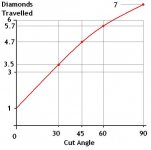Colin Colenso said:
...Anyone want to offer the full solution or a good rule of thumb formula?
Colin, here is the predicted ratio of distances in a nutshell. You might want to imagine a cut shot to the left with the y-axis aligned with the cueball's pre-impact direction and the x-axis pointing to the right as seen from above. Let the distances the cueball travels in the final roll direction during post-impact sliding, and then rolling, be Xcs and Xcr. Let the corresponding object ball distances be Xos and Xor. Then the ratio of distances Rd is:
Rd = (Xcs + Xcr)/(Xos + Xor)
In this ratio, the cueball's pre-impact velocity V and the gravitational acceleration g are common in the numerator and denominator and therefore cancel out. But they're included in the following formulas for the four distances.
Let Us and Ur be the coefficients of sliding friction and rolling resistance, respectively (approx. 0.2 and 0.01). Let Vcs be the cueball's initial post-impact velocity component in the direction of its final roll (as it just begins sliding along the tangent line), and Vcr be its velocity in the roll direction just as it reaches natural roll. For the object ball, let the corresponding velocities be Vos and Vor. Then, using a standard kinematic formula:
Xcs = (Vcr^2 - Vcs^2)/(2gUs)
Xcr = Vcr^2/(2gUr)
Xos = (Vos^2 - Vor^2)/(2gUs)
Xor = Vor^2/(2gUr)
The four velocities in the above are as follows. Let C be the cut angle and F the cueball's final direction measured with respect to the x-axis (positive counterclockwise). The angle F is:
F = arctan[sin(C)^2 + Bz/R)/(sin(C)cos(C))]
The quantity Bz/R is equal to 2/5 for a rolling cueball, but the equation holds for other values. That is, you can characterize its spin state as if it had been hit by an idealized squirtless cue anywhere above or below center by the fraction of its radius, Bz/R. According to the miscue limits, Bz/R ranges from +0.5 (max topspin) to -0.5 (max draw), and is 2/5 when at natural roll as just mentioned. The complement of the angle F, which is 90 - F, is close to 30 degrees for a wide range of cut angles (eg, the 30-degree rule). With this, the four velocities are:
Vcs = Vsin(C)cos(F - C)
Vcr = (5/7)Vsqrt[(1 + 2(Bz/R)sin(C)^2 + (Bz/R)^2]
Vos = Vcos(C)
Vor = (5/7)Vcos(C)
Note that sin(C)^2 denotes the square of sin(C). These can be corrected for throw (particularly the slight loss of spin during the collision) and inelasticity, but I'm not sure you're going to use them, so I'll leave it at that.
If you're going to be doing such analysis in the future, you might want to get comfy with the relation which gives the final vector velocity of a spinning ball as it reaches natural roll. If its spin is
W and initial velocity
V, its velocity
Vr at natural roll is:
Vr = (5/7)[
V - (2/5)
W X R]
where
R is the displacement vector from the center of the ball to the "point" of contact with the bed and
X denotes the vector cross product. This is derived in one form or another by Dr. Dave and Ron Shepard in their technical articles. It can also be easily gotten by noting that 2/7'ths of the relative surface velocity between the ball and the cloth is subtracted from the ball's initial velocity (a fact which comes from the moment of inertia of a sphere = (2/5)m R^2):
Vr =
V - (2/7)[
V +
W X R]
where [
V +
W X R] is the relative surface velocity.
For figuring the post-impact velocity of the cueball as it reaches natural roll, a more convenient form is:
Vr = (5/7)V[sin(C)cos(C)
i + (sin(C)^2 + Bz/R)
j]
where
i and
j are the standard unit vectors in the x and y directions (the cueball's pre-impact velocity is again aligned with the y-axis). Bz/R is as described earlier. Dividing the y-component by the x-component yields the formula for the tangent of the angle F used above, which is measured with respect to the x-axis and is positive in the counterclockwise sense. (Note: this latter form of the equation doesn't include a term for swerve, ie, if
W has a component in the y direction.) You can use this to make a simple geometric construction that gives you the cueball's final direction at natural roll for any amount of draw or follow.
The magnitude of the cueball's velocity at natural roll, Vcr above, comes from taking the square root of the sum of the squares of the x and y-components, and a little algebra.
**********************************
Edit: The equation for Xcs, the distance traveled by the cueball in the final roll direction (but while still sliding) should be:
Xcs = (Vcr^2 - Vcs^2)/(2gUscos(B-F))
where the angle B is the direction of the cloth friction force measured from the x-axis as with F. It is:
B = arctan[cos(C)/(-sin(C))]
The implied plus sign on cos(C), and the minus sign on sin(C), place this direction in the correct quadrant when evaluating the arctan function. Sorry about that.
Jim


